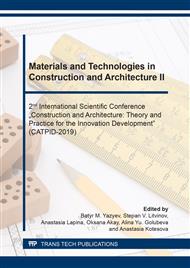[1]
Information on https://ec.europa.eu/clima/policies/strategies/2050_en.
Google Scholar
[2]
Information on https://www.un.org/sustainabledevelopment/ru/climate-change.
Google Scholar
[3]
T. Schneider, C. M. Kaul, K. G. Pressel, Possible climate transitions from breakup of stratocumulus decks under greenhouse warming, J. Nature Geoscience. 12 (2019) 163-167.
DOI: 10.1038/s41561-019-0310-1
Google Scholar
[4]
Benjamin D. Santer and others, Celebrating the anniversary of three key events in climate change science, J. Nature Climate Change. 9 (2019) 180-182.
DOI: 10.1038/s41558-019-0424-x
Google Scholar
[5]
Gartner, E., Industrially interesting approaches to low-CO2, cements. Cement and Concrete Research. 34 (9) (2004) 1489-1498.
DOI: 10.1016/j.cemconres.2004.01.021
Google Scholar
[6]
Karen L. Scrivener, Vanderley M. John, Ellis M. Gartner. Eco-efficient cements: Potential economically viable solutions for a low-CO2 cement-based materials industry. Cement and Concrete Research. 114 (2018) 2-26.
DOI: 10.1016/j.cemconres.2018.03.015
Google Scholar
[7]
S. A. Pereverzeva, P. K. Konosavsky, A. V. Tudvachev, I. L. Kharkhordin, Disposal of carbon dioxide industrial emissions in geological structures, Vestn. St. Petersburg un-ta. Ser. 7. Geology. Geography. 1 (2014) 5-21.
Google Scholar
[8]
Benson S. M., Carbon dioxide capture and storage: Overview with an Emphasis on Geological Storage, Earth Sciences Division Lawrence Berkeley National Laboratory. Berkeley, California, (2005).
Google Scholar
[9]
M. Schneider, M. Romer, M. Tschudin, H. Bolio, Sustainable cement production- present and future, Cement and Concrete Research. 41(7) (2011) 642-50.
DOI: 10.1016/j.cemconres.2011.03.019
Google Scholar
[10]
D.K. Panesar, L. Mo, Properties of binary and ternary reactive MgO mortarblends subjected to CO2 curing, Cem. Concr. Compos. 38 (2013) 40-49.
DOI: 10.1016/j.cemconcomp.2013.03.009
Google Scholar
[11]
R. Maddalena, J.J. Roberts, A. Hamilton, Can Portland cement be replaced bylow-carbon alternative materials? A study on the thermal properties and carbon emissions of innovative cements. J. Clean. Prod. 186 (2018) 933-942.
DOI: 10.1016/j.jclepro.2018.02.138
Google Scholar
[12]
Х. Polmann, Ways to reduce CO2 emissions in the production of alternative cements, Cement and its use. 2 (2016) 89-101.
Google Scholar
[13]
Y. Kim, K. Lee, Mechanical properties of non-cement mortars fabricated under supercritical carbonation conditions without alkali activators and composed of fly ash and fused waste slag, Mater. Today: Proceed. 3 (2016) 381 – 390.
DOI: 10.1016/j.matpr.2016.01.024
Google Scholar
[14]
D. Badagha, C.D. Modhera, M55 Grade Concrete Using Industrial Waste To Minimize Cement Content Incorporating CO2 Emission Concept: An Experimental Investigation, Mater. Today: Proceed. 4 (2017) 9768–9772.
DOI: 10.1016/j.matpr.2017.06.264
Google Scholar
[15]
N.V. Lyubomirskiy, S.I. Fedorkin, A. Bakhtin, T. Bakhtina, Structuring of composite systems based on lime harden through carbonation and secondary limestone raw materials, Malays. Constr. Res. J. 23(3) (2017) 15-26.
Google Scholar
[16]
N. Lyubomirskiy, A. Bakhtin, T. Bakhtina, Alternative approach to the organization of hardening of dolomite binding materials, IOP Conf. Series: Mater. Sci. Eng. 365 (2018).
DOI: 10.1088/1757-899x/365/3/032032
Google Scholar
[17]
N. Lyubomirskiy, A. Bakhtin, T. Bakhtina Physicochemical principles of СО2 sequestration in building materials based on nepheline slime, IOP Conf. Series: Mater. Sci. Eng. 463 (2018).
DOI: 10.1088/1757-899x/463/3/032065
Google Scholar
[18]
De Silva P., L. Bucea, D.R. Moorehead, V. Sirivivatnanon, Carbonate binders: Reaction kinetics, strength and microstructure, Cement & Concrete Composites. 28 (2006) 613–620.
DOI: 10.1016/j.cemconcomp.2006.03.004
Google Scholar
[19]
N.V. Lyubomirskiy, S. Fic, S.I. Fedorkin Investigation of Physical and Mechanical Properties of Construction Materials of Forced Carbonate Hardening, Materials Science Forum «Materials and Technologies in Construction and Architecture». 931 (2018) 475-480.
DOI: 10.4028/www.scientific.net/msf.931.475
Google Scholar
[20]
N. Vlasopoulos, C.R Сheeseman US Patent 8,496,751. (2009).
Google Scholar
[21]
N. Lyubomirskiy, S. Fedorkin, T. Loktionova, А. Bakhtin, Ukraine Patent 28051. (2006).
Google Scholar


